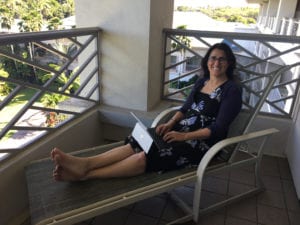Posted by: Anna Miller, PhD student, Case Western Reserve University
See Part 1 of this interview, which focuses on Dr. Crawford’s career.

We touched base with Dana Crawford, PhD, to share her perspectives and experience in science communication.
ASHG: Tell us about how you use science communication in your career.
Dr. Crawford: My use of science communication is constant as effective communication is essential for a productive and successful career in science. The main staples of science communication in academia are manuscripts, grants, and oral presentations. What you may not realize if you are a trainee is that there is much more communication required than these common forms. I write letters of support, progress reports, abstracts, posters, summaries, and, of course, emails. While these are not peer-reviewed and not necessarily CV-citable, they are still important means of science communication. Lately, I have also tried my hand at blogging as an informal means of communication. Like it or not, an internet presence is a must to better ensure you are invited to meetings to communicate your science.
ASHG: What stands out to you in an oral presentation?
Dr. Crawford: The most effective oral presentations are organized to tell a story. That is, no matter the length, an effective presentation has a story arc with a beginning, middle, and end. Conversely, the least effective presentations are those that just present a string of data slides with no obvious order or connections between them. As the speaker, you might think this data parade is impressive to the audience. But, for the audience member, it is difficult to digest and signals to us that you did not take the time to construct a story to help us understand what you did and, importantly, why you did it. If I come away from your talk and think, wow, that was so interesting—I want to learn more about what the person is doing, then you have done your job in effectively communicating your science. A second feature of effective oral presentations is making nice, clean slides. Clashing colors, small figures and font sizes, and text-heavy slides distract from your story and lessen the effectiveness of your science communication.
ASHG: What resources can we use to improve our writing?
Dr. Crawford: Practice, practice, practice! Seriously. Many of us love collecting data and crunching the numbers, but fewer of us love the write-up. Call me old-fashioned, but if your project’s results are not published in a peer-reviewed journal, then the project and those data might as well not exist.
For manuscript writing, I am often inspired by the peer-review literature itself. I identify journals that have published similar work and read a few of those papers. Of those that I enjoyed reading, I examine the paper’s structure for ideas on how to structure my own work and present the data (figures and tables). I also rely on my collaborators and colleagues to help construct the overall story of the manuscript and to comment on the drafts. Much like the oral presentation, we need to construct a beginning, middle, and end, all guided by the initial study question and our interpretation of the data. The hardest part of manuscript writing is getting started. Here, it is best to know thyself. When and where do you write best? Answer these two questions, block off some time, and start constructing those figures and tables.
Grant writing, I have learned, is a different animal. Unlike the peer-reviewed literature, it is more difficult to get your hands on a grant to use as an example for your own proposal. NIH provides detailed instructions on the sections required for each grant type, and exceptions or required additions are further detailed in individual NIH Funding Opportunities and Notices. NIH also provides access to a few funded (successful) grants redacted of personal information (e.g., https://www.niaid.nih.gov/grants-contracts/sample-applications).
As a trainee, you could also ask your mentor for grant proposal and summary statement examples. For both trainees and investigators, most major research universities provide periodic grant workshops. If your institution does not provide a workshop, there are external workshops and reference material such as The Grant Application Writer’s Workbook. When writing the proposal, it is essential to keep in mind the audience–the reviewers. Be sure to read and understand the criteria by which proposals are scored for optimal results. And, like the manuscript, it is always helpful to solicit comments from collaborators and colleagues.
ASHG: What is important to communicate when talking about big data and new technologies?
Dr. Crawford: Talking about big data and new technologies is always fun. Their potential is exciting, and the possibilities seem endless. When communicating this science, it is important temper the excitement with a frank assessment of their limitations. This critical assessment is particularly important when communicating science to a lay audience. Overpromising now inevitably leads to disappointment and distrust later.
ASHG: What are your favorite genetics websites and Twitter feeds?
Dr. Crawford: I do not yet have a favorite genetics website or Twitter feed. I do have a new favorite podcast, though! In Those Genes is a hip-hop inspired podcast founded and hosted by Dr. Janina M. Jeff. I admit I am biased in this review, but I think this podcast provides a nuanced take on issues related to genetics and society with an emphasis on genetic ancestry and its meaning for African Americans.
